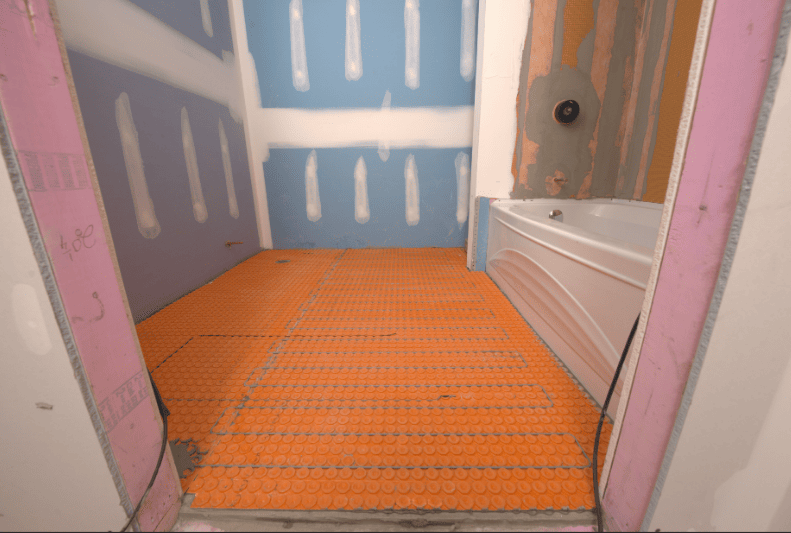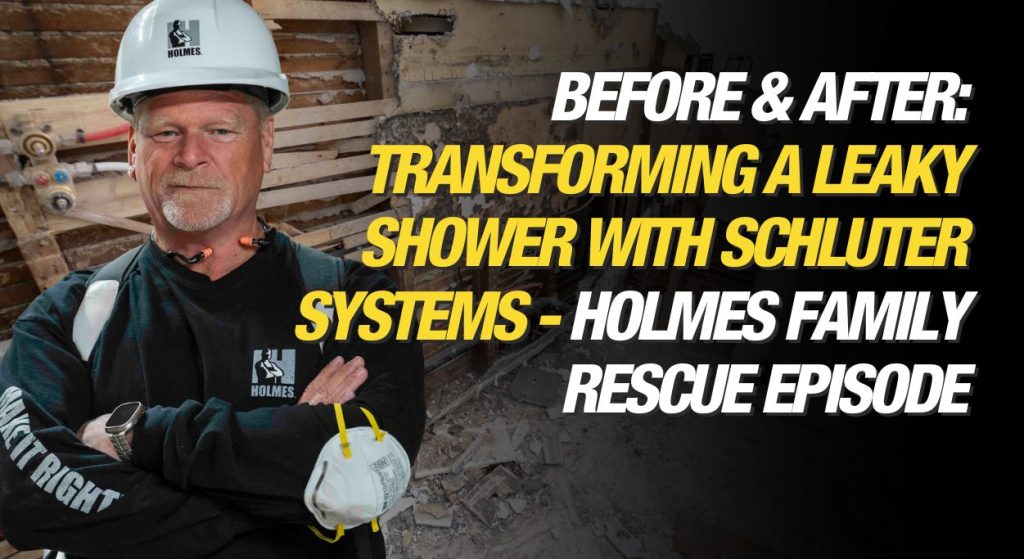Your gutters play a bigger role in protecting your home than most people realize. Be aware of these 9 signs your gutters were installed incorrectly. When they’re installed properly,...

In-Floor Warming Systems Explained
By Sherry Holmes
Mike’s Advice / Bathroom Renovation
Tuesday, June 1st, 2021 @ 1:00am
As a Holmes crew member, I’m often asked about different products that we use on our shows. One of the most commonly asked questions I hear is, ‘What’s the orange stuff you use in bathrooms?’ Well, the orange stuff is what keeps our feet warm and our bathrooms protected. In this article, I am going to explain in-floor warming systems and your options.
If you watched Holmes+Holmes Season 1 (or any of our bathroom renovation jobs for that matter), then you know what I’m referring to. The orange products that you always see us using on our shows are Schluter systems products. I’ve been using Schluter systems for years and am always amazed at how well they perform and the advancements Schluter continues to make.

If you are planning a bathroom remodel, I strongly recommend looking into the Schluter waterproofing and heated floors systems. Those products have never failed us and there are lots of resources available online for reference and reviews.
Types of In Floor Heating Systems
What is the best floor heating system? There are two types of underfloor heating systems – electric and water-based systems.
Electric floor warming systems use cables or resistance wire heated by electricity, while water-based systems circulate water from a boiler or water heater through polyethylene tubing below the floor.
Another difference is that the electric systems are normally designed to warm the floor, while the water (hydronic heat) systems actually heat the room and can replace other central heating systems.
RELATED:
Renovating Your Bathroom? Here are some Do’s and Don’ts Of Your Bathroom Remodel
Hydronic Heat vs Electric Floor Heating
You know how heat rises? That’s how hydronic floor warming works, warming a room from the floor up – spreading it evenly throughout the whole room. In-floor warming systems don’t need to run as high or cycle on and off like conventional furnaces and radiators have to do, to keep things warm.
Electric floor warming systems, on the other hand, provide consistent temperature, so you don’t get hot or cold spots on the floor. Plus, walking on a warm floor on a cold winter’s morning just makes me feel the chill a lot less.
We use DITRA-HEAT, and it is suitable for applications with engineered wood, vinyl, wood plastic composite, luxury vinyl tiles, luxury vinyl planks, stone plastic composite tiles and planks, and laminate flooring.

As an added bonus, because heated floors still feel warm in decreased air temperatures, you can even keep your programmable thermostat a little lower in the winter, and still stay comfortable.
These systems are energy efficient, which means lower energy bills each month – and now that I’m a homeowner, I really appreciated those savings.
RELATED:
Heated Tile Floors For Renovations?
Over the last several years, heated tile floors and in-floor warming systems have become a popular trend in homes across the globe. You may have seen floor heating systems installed in kitchens, bathrooms and other areas where tile is installed.
Before new and advanced technology took effect, in-floor warming systems were only considered for pre-construction builds. Today heated tile floors can easily be installed in an existing home. If you are doing a bathroom remodel and replacing your bathroom flooring, this is a great time to consider heated tile floors.
I’ve even installed a lot of them personally. While lots of people may still think about this as a luxury feature, they offer a lot of benefits for your home.
Pros and Cons of Electric Floor Warming Systems:
Benefits of an electric floor warming system:
- Programmable thermostat allows for energy savings
- Suitable for multiple floor coverings, including tile and laminate floors
- Consistent temperature
- Can be installed during a bathroom remodel
- Does not blow dust and allergens around the way forced hot air systems do.
Cons of an electric floor warming system:
- Must bring in a professional to install it, I do not recommend this as a DIY project
- Existing flooring will need to be replaced to accommodate this
Why We Use Schluter Systems
I’m the tiler of the Holmes family, so I love that stone and tile floors are especially known to keep their heat, meaning floor warming systems work more efficiently.

If you’ve seen heated floors before, you’ll notice that you often see them installed in bathrooms, kitchens, and other rooms that have tile flooring.
Schluter’s electric floor warming system includes uncoupling technology in their DITRA-HEAT line, which keeps your tiled floors and grout from cracking. I may love tiling but I don’t love having to redo my work, so I use DITRA-HEAT in a lot of our jobs. For us, it’s easy to install.
Programmable Thermostat
Floor warming systems are programmed using a separate thermostat from your furnace. The system attains the desired temperature that you set, providing a comfortable and consistent temperature without overheating.
Nothing is better than a hot bath after a cold day on the job site – but who likes putting their bare feet on a cold tile? On our sites we install the touchscreen, programmable DITRA-HEAT Wi-Fi Thermostat. The thermostat controls your DITRA-HEAT in-floor warming system.
It provides convenience, control, and easy access to my in-floor heating system from my mobile device, meaning that before I come home after a long day, I can make sure my heat is turned up and ready to go, while I warm my tub.
Other Bathroom Features to consider

- Do you want to create a partition between your shower and the rest of your bathroom? You may want to install a knee wall.
- Are you installing a curbless shower? Think about your shower drain choices.
- Do you really want to spend that much money on your fancy finishes? Think about installing a high efficiency toilet instead.
- Do you have young children? If yes, you may have to hold on to that tub in your house.
- Do you need extra storage in your shower? You should install a shower niche.
Whatever your bathroom remodel looks like, NEVER attempt home improvement projects yourself unless you are the skills to do so professionally. You can cause a lot of structural damage if your bathroom isn’t installed well. And if you decide to hire a professional? Do your research on them and read these tips on how to hire a contractor.
READ NEXT:










